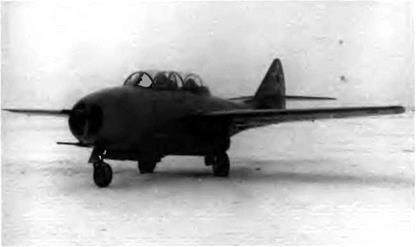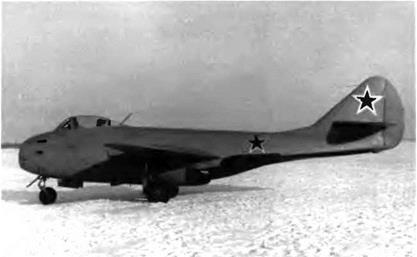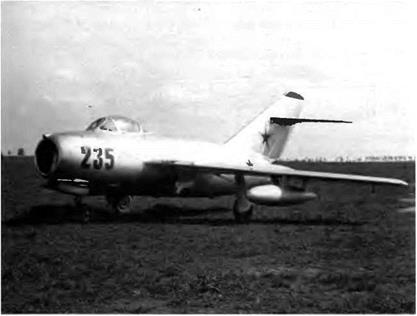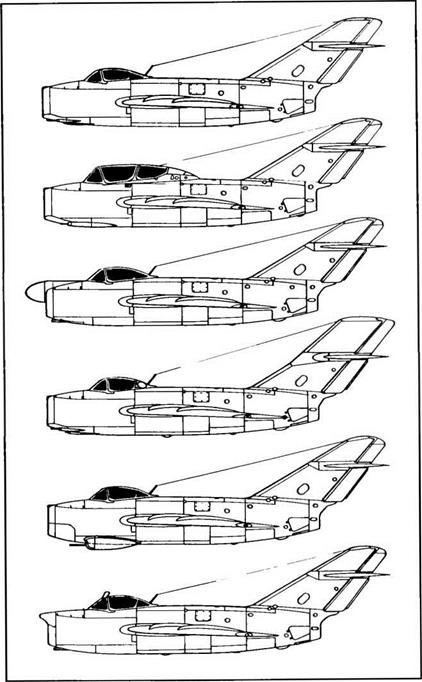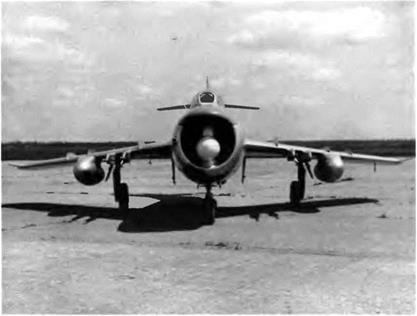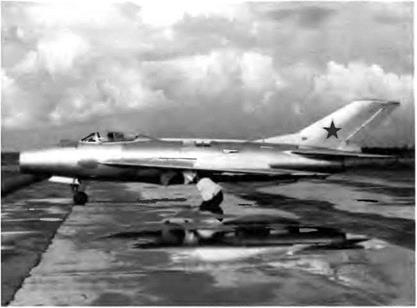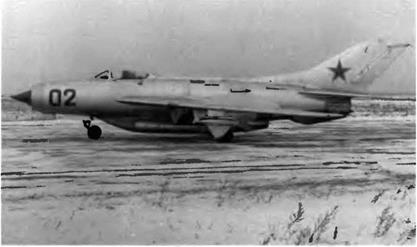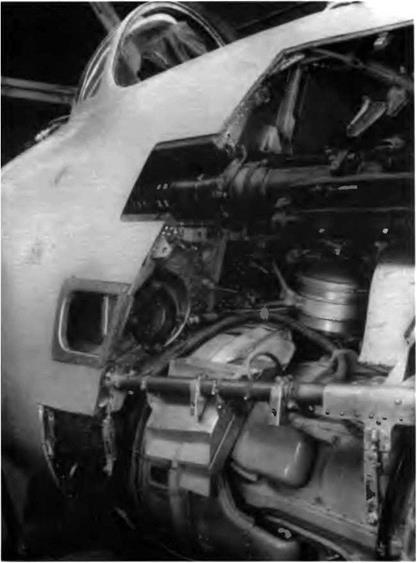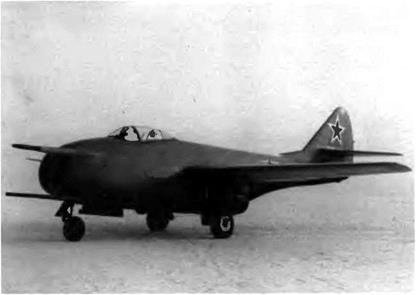While one ОКБ team was at work on the 23-01, another tried to show that the variable geometry wing concept was well founded. Both projects were aimed at one objective: aircraft capable of speeds of Mach 2-2.3 and STOL performance. The 23-11 fuselage was shaped like a pointed cigar developing into a rounded-off angled square between frame nos. 18 and 20. The structure located in the midst of these two bulkheads was essential: it was the wing’s center section, plus a fuel tank into which the air intake duct passed. The attachment fittings for the actuating cylinders of the main gear as well as the front ends of the gimbal joints were secured to its rear face (frame no. 20). The body then tapered to frame no. 28, where the whole rear fuselage could be detached to ease field maintenance and engine removal.
Bulkhead no. 31 at the rear of the fuselage supported the hinges for the four airbrakes, the support bearing for the stabilator, and the rear attachment fitting for the vertical fin. The skin was fabricated out of panels connected by fusion welds and then riveted. The wing box was made of the two main spars. The minimum sweep angle at the leading edge was 16 degrees, increasing steadily to a maximum of 72 degrees. Wing sweep was controlled by an SPK-1 hydraulic system whose two ball-screw actuators transformed spin to linear motion. Those actuators were linked directly to each wing’s pivot arm. Pins were located on the center section 1,500 mm (59.06 inches) on either side of the fuselage datum line and lengthwise 128.5 mm (5.05 inches) ahead of bulkhead no. 20.
The wing’s sweep angle could be modified by a control lever on the left console of the cockpit, and the pilot could follow the movement via the wing position indicator on the instrument panel. Each wing had leading edge (LE) flaps; single-slotted trailing edge (ТЕ) flaps, in four sections; and two-section upper surface spoilers/lift dumpers forward of midflap sections. Extension of the LE and ТЕ flaps was linked, but the LE controls featured a nonlinear mechanism that kept the angles from being identical. If the ТЕ flaps were at 25 degrees at takeoff, the LE flaps were at 17 degrees; and when the ТЕ flaps were at 50 degrees at landing, the LE flaps were at 19 degrees (their maximum). LE and
|
In this photograph the 23 11/1 has its wing set at the maximum sweep angle of 72 degrees.
|
ТЕ flaps remained linked only if the wing was set at 16 degrees. Above that, the linkage rods automatically disengaged.
On the wing’s upper surface, each spoiler was hinged on the rear mam spar and acted like an aileron when operating differentially in conjunction with the horizontal tail surfaces. With a 16-degree wing sweep angle, its maximum deflection travel was 45 degrees. With a 72- degree wing sweep angle, the spoilers locked in the retracted mode and roll control was provided only by the horizontal tail surfaces operating differentially (tailerons). Between 16 and 72 degrees, the spoiler angle changed according to the sweep angle chosen by the pilot. Rudder control was provided by an irreversible servo-control unit supplemented by spring mechanisms to transmit the "feel." Operating spoilers instead of ailerons avoided the risk of wing twist when displacing ailerons at high speeds.
The 23-11 prototype was powered by the Khachaturov R-27F-300 (product 41) rated at 5,095 daN (5,200 kg st) dry or 7,645 daN (7,800 kg st) with afterburner The nozzle area could be adjusted by means of a double ring of small flaps. Engine power was regulated at all ratings by a single linear throttle (the first of its kind at MiG), the variable geometry air intakes, and the blow-in doors (two for each intake duct). The specific fuel consumption of the 23-11/1 in level flight was 25 percent less than that of the MiG-2 IS with the much less powerful R-l 1F2-300
The UVD-23 control system of the boundary layer splitter plates offered full thrust at any and all times and ensured that the engine functioned reliably at all ratings in the aircraft’s flight envelope. The leading edges of the splitter plates at the air intakes stood 55 millimeters (2.16 inches) away from the fuselage wall, forming a boundary layer bleed duct. The UVD-23 apparatus was useful for setting the splitter plates to the most suitable position as the engine compressor pressure ratios ranged between 4 and 11. Automatic control took over when the aircraft reached Mach 1.15 and was governed by the deflection of the stabilator.
In the 23-11/1, 4,250 1 (1,122 US gallons) of fuel were distributed among three fuselage integral tanks of 1,920, 820, and 710 1 (507, 217, and 188 US gallons) and six wing structural tanks: two each of 62.5, 137.5, and 200 1 (16.5, 36.3, and 52.8 US gallons). The first production machines also carried a drop tank under the fuselage Because wing sweep varied, the fuselage-to-wing fuel and air lines passed through telescopic swivel joints.
The lower segment of the large ventral fin was hinged to fold to starboard when the landing gear was extended. The three gear legs were fitted with levered suspension. The main gear featured KT-133 trailed wheels with 830 x 225 tires (later increased to 830 x 300). The front leg had twin wheels with 520 x 125 tires and was fitted with the MRK-30 nosewheel steering mechanism, a shimmy damper, and a wheel centering device. All wheels were equipped with hydraulically controlled disc brakes. As the aircraft was being planned, conceiving the gear was like trying to square the circle. Because of the variable geometry concept the gear had to be housed entirely into the fuselage, but at the same time the wheel track had to remain fairly broad. This explains the seeming complexity of its kinematics.
The PT-10370-65 tail chute with an area of 21 m2 (226 square feet) was housed in a cylinder at the base of the rudder with split cone – shaped doors. Armament of the 23-11/1 included four air-to-air K-23 missiles (two under the wing glove and two under the fuselage); during the tests K-13 missiles were also fired.
The 23-11/1 was moved to the test center on 26 May 1967, and after the usual ground and runway exercises the aircraft made its first flight on 10 June 1967 under the guidance of OKB chief pilot A. V. Fedotov. The first thirteen flights were devoted to preparing for the Domodyedovo air show. During that event on 9 July Fedotov gave a brilliant demonstration of all the capabilities of the VG concept. Subsequent flights explored the flight envelope and assessed the efficiency of the air intakes.
On 9 July 1967 at the Domodyedovo air show, Fedotov put on a remarkable demonstration of the 23-11 variable geometry aircraft. It was the prototype’s fourteenth flight.
The R-27F-300 reached its twenty-five hour life limit on the prototype’s forty-fifth flight. Tests resumed in January 1968 after the engine was replaced and the aircraft was equipped with the three-axis AP-155 autopilot. In early April the 23-11 moved to an airfield not far from a firing range to examine the operation of the air intakes and turbojets as well as the aircraft’s handling characteristics when firing K-13 and K-23 missiles. Those tests took place between 8 April and 24 April. P. M. Ostapyenko and M. M. Komarov fired sixteen unguided missiles (the aircraft did not yet have radar). No surges or flameouts occurred between 5,000 m (16,400 feet) and 17,000 m (55,760 feet) and speeds of
Mach 0.7 to Mach 1.8 during the firing tests. The basic test schedule ended in July after ninety-seven flights. The factory report concluded:
The MiG-23 variable geometry wing offers many advantages, such as
— a significant reduction of the takeoff and landing rolls (compared with those of all other existing aircraft in the same category)
— a great ease of handling in the entire flight envelope and especially at takeoff and landing
— a high indicated airspeed (IAS) at low altitude and, at maximum sweep, low g-forces in rough air
— a long range and a high flight endurance at cruise rating
Design performance should be met with the more powerful R-27F2-300 turbojet (product 47) that the aircraft needs.
On 6 November 1968 A. I. Mikoyan confirmed the 23-11/1 factory test report. This prototype, with its original markings, can be seen today in the VVS museum on the Monino airfield near Moscow.
Specifications
Span (72′ sweep), 7.779 m (25 ft 6.3 in); span (16° sweep), 13.965 m (45 ft 9.8 in); fuselage length (except probe), 15.795 m (51 ft 9.8 in); wheel track, 2.658 m (8 ft 8.7 in); wheel base, 5.772 m (18 ft 11.3 in); wing area (72° sweep), 29.89 m2 (321.74 sq ft); wing area (16° sweep), 32.1 m2 (345.52 sq ft); takeoff weight in clean configuration, 12,860 kg (28,345 lb); takeoff weight with four K-23 missiles, 13,300 kg (29,315 lb); wing loading (72° sweep), 424.2-445 kg/m2 (86.9-91.2 lb/sq ft); wing loading (16° sweep), 400.6-414.3 kg/m2 (82.1-84.9 lb/sq ft); max operating limit load factor, 3.1.
Performance
Max speed in clean configuration (72° sweep), 2,240 km/h or Mach 2.12 at 13,600 m (1,208 kt at 44,610 ft); max speed with two K-23 missiles (72° sweep), 2,255 km/h or Mach 2.13 at 13,400 m (1,217 kt at 43,950 ft); max speed with four K-23 missiles (72° sweep), 2,025 km/h or Mach 1.905 at 12,800 m (1,214 kt at 41,985 ft); service ceiling, 17,200 m (56,415 ft); landing speed, 230 km/h (124 kt); takeoff speed, 270 km/h (146 kt); feriy range with two underbelly K-23 missiles (16° sweep), 2,045 km (1,270 mi); takeoff roll, 320 m (1,050 ft); landing roll with tail chute, 440 m (1,445 ft); landing roll without tail chute, 750 m (2,460 ft).











